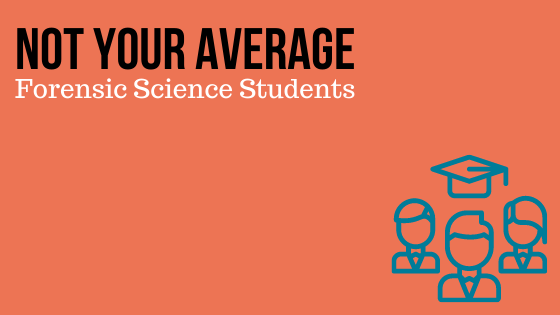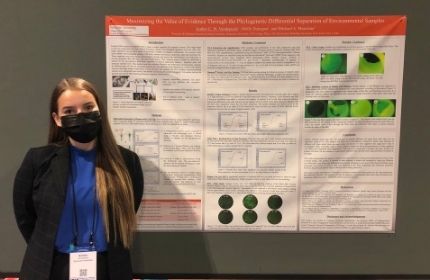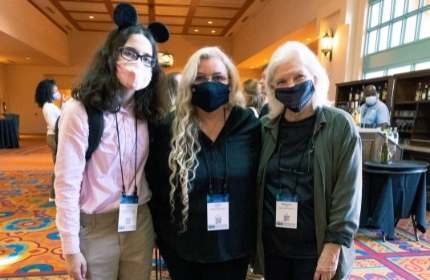Today’s blog is written by guest blogger Ann MacPhetridge, Promega. Reposted from The ISHI Report with permission.
I was lucky to have the opportunity to interview our Student Ambassadors for ISHI 32: Amber Vandepoele, Olivia McCarter, Nidhi Sheth, and Halley Fallang. Each of these young women are pursuing excellence in their own way. When a path isn’t readily apparent, they simply make one.
I’m never quite sure what to expect during these interviews, and while I have a standard set of questions, I will often let the personality of the student ambassador guide the direction of the interview. As you can imagine, the four young women differ in personality and educational focus but are alike in that each are driven by a desire to have a real impact on forensics and to share their knowledge and passion for this field with others.
Nidhi Sheth
Nidhi, a PhD student at Rutgers University, is the first of my student interviews. She’s got a smile that lights up the recording studio, and although she seems nervous about what I may ask her, she’s also obviously open to whatever comes.
Nidhi’s poster at ISHI described the research she’s done on deconvoluting bulk mixture samples at the front end of processing to help solve complex mixture challenges. Her PhD work involves deconvoluting a mixture into single cells to separate epithelial cells, sperm cells and white blood cells, all of which are typically encountered in violent crime scenes. They then work to get a human profile from that single cell. Additionally, she’s working under the guidance of her PI, Catherine Grgicak and collaborators to develop statistical tools for interpretation of single cells. According to Nidhi, “The amount of information that a single cell holds, just blew my mind, so I’m trying to get in-depth knowledge and trying to help in whatever way possible.”
Nidhi’s grandfather, a criminal lawyer in India has been her biggest inspiration. Lawyers run in the family, as her mother and many others on her mother’s side of the family are attorneys. Her biggest drive to study forensics is the number of people looking for answers and justice, particularly those that are voiceless or that have been victims of abuse in their lifetimes.
She’s driven to find justice for women, whether by assisting in the development of a new method that helps identify perpetrators or by working to find ways to reduce crimes against women. She recognizes that working in forensics provides opportunities to give back to the community and provide justice to victims.
“Just knowing that people need justice, that’s my inspiration, and it’s always been my inspiration. I am from India, and I read this article a couple of years that said that every 15 minutes, a woman gets raped. I have that article hung in my house, and when I walk out, I read that post every single day.”
We move on to some getting to know you questions, the first one asking about what superpower she wishes she had. She smiles as she tells me that she wants to be Sherlock Holmes and to have his powers of deduction and his good eye for detail and observational skills.
An admirer of the Dalai Lama, she selects him when asked with whom she would choose if given the option to have dinner with anyone, dead or alive. She shares her curiosity about finding balance and peace within ourselves, especially when you don’t have all the answers to questions, something that as a PhD student she’s experienced on occasion.
As if pursuing a PhD wasn’t enough of a challenge, Nidhi also is involved in a podcast, entitled “Beyond the Yellow Tape”, where she and a colleague break down aspects of forensic science to inspire kids or others who may be considering a career in forensics.
To burn off the stress of experiments that didn’t necessarily go as planned, she kickboxes and teaches dance. A trained classical dancer, she may have opted for a career teaching dance to children, instead of working crime scenes. I can’t help but think of what a loss to the forensics community that might have been had she made that choice instead.
Nidhi describes herself as tenacious, hardworking, and dedicated to her work. I suspect that someone on the Promega ISHI team will be interviewing her at ISHI 52 about a breakthrough that she and her team have made in the study of forensic DNA.
Amber Vandepoele
Amber is a cheerful, outgoing conversationalist with infectious youthful enthusiasm. She first became interested in forensics elective course when she took a class in high school. A guest lecturer shared their experiences working as a forensic DNA analyst and she instantly thought, “I can do that!” From there she researched various programs at universities in the US, choosing Syracuse University, where she is an undergraduate studying forensics and biochemistry.
What drew Amber to forensics is the impact that it can have on people’s lives. Her values come through as she shared her desire to help people.
“In a lot of scientific fields or at some companies in the field, the purpose isn’t really something that I valued or related to. They’re working to make money and not contribute to something. In forensics you can help families or bring some sort of closure. I want to be a part of something that is bigger than just you and doing your job.”
Recognizing that it’s more than just a job, Amber is enthusiastic about empowering women, BIPOC students and other marginalized groups to pursue careers in STEM, including the forensics field.
Amber’s poster at ISHI was entitled “Phylogenetic Differential Separation of Environmental Samples: The First Step in Improving Mixed Species Sequencing Results”. Currently casework laboratories target a single species, human DNA for amplification for genetic identity. Amber’s work suggests that there are advantages to characterize multiple species as they may be able to provide additional probative information that can be used in the case investigation. Her research is designed to optimize methods that separate plant, microbial, and human cells into separate fractions. Separating these cell types enables laboratories to analyze each fraction as appropriate. By doing so, more complex DNA mixtures could be more easily interpreted and enable more information to be obtained from each sample. Additionally, they can use the microbial and plant fractions to assist in determining the location where a piece of evidence was originally.
Though passionate about forensics, if she was to do something else, she would choose medicine, again for the ability to help and serve others. Her dream job is a DNA analyst at a crime laboratory. “I like the puzzle that comes with that as well as the lab work”. Looking to the future, she would like to work in a crime laboratory in California, Atlanta, or Seattle. “Living in Syracuse, I’ve had enough experience with the cold and snow!”
Her interest in forensics extends beyond her school life. She often unwinds by watching true crime and forensics shows. “Any Netflix documentary on true crime—I love it!”
Smiling shyly, she told me that honest, funny, and driven were the best descriptors for herself. She tries to balance the seriousness of her studies and her laboratory work with sarcasm and humor. A foodie at heart, Amber loves going with friends and family to explore new restaurants. “If I’m not doing something, I’m like let’s go eat!” The Obamas make the top of her list for dream dinner companions.
Amber is not a fan of flying after having a couple of miserable experiences at airports recently so she chose the ability to fly as her most desired superpower. “I’ve had some stories, so I would love to be able to fly anywhere for free!”
Amber focused her time at ISHI networking with various vendors, speakers and her fellow students. Her favorite part of ISHI was visiting the exhibit hall and talking to vendors about their products and what new technologies they had for crime laboratories.
Olivia McCarter
Dressed casually in a t-shirt and jeans, Olivia strikes me as your typical teenager. What I soon learned, however, is that she is anything but typical. In fact, Olivia solved her first cast at age 18 using investigative genetic genealogy (IGG) tools. Olivia focuses her work in the Southeastern US, primarily in Alabama and Mississippi, working on infanticides and child homicides.
Olivia has been interested in forensics from a young age. Reading about the success with the Golden State Killer case motivated her to reach out, even though she was still a high school student, to those working in IGG, asking what she could do to help. It’s clear she’s found her calling—she has this laser intensity and focus as she describes what doing this work means to her. She’s made this her career, despite not being old enough to drink alcohol in most states.
“I didn’t know that I wanted to do genealogy for the rest of my life until after I solved my first case. That was Harry who was identified in April of 2020. His family knew of his death, but his body wasn’t recovered until we gave him back to them and they buried him.
There are just so many people out there who haven’t been identified. There are more than 100K in the US alone who are unidentified. All of them have families. All of them were people just like you and me. They could have been sitting right next to me. So that’s what really drives me–giving these people back to their families.”
Her poster at ISHI described the IGG work she’s doing to solve infanticide cases. “In my poster I describe my biggest passion—the use of IGG for solving Infanticide cases, children under the age of one. I give an example of case that hasn’t been solved yet from Jackson County, MS…”
Olivia feels a strong connection to the victims of the crimes she investigates. It’s clear when talking to her that she internalizes these cases while working them and works tirelessly to find answers. She maintains relationships with loved ones of the victims, considers them and the victim to be her family. One touching detail she shares with me is that she creates a nickname for each of the unidentified victims, rather than referring to them as Jane or John Does. She adamantly believes that these aren’t just case numbers, but that there are real people, real children involved in these horrific cases. Her connection to these victims is evident and I hear the emotion in her voice as she says, “We give them names to call them, and we love them until we can give them back to their family”.
Her dedication to the victims is so strong that after a case is solved, she gets a tattoo to remember each victim. She proudly shows me a tattoo on her lower arm, one of three small flowers just like those that were on the dress of one of young victims, Alisha Ann Heinrich, an 18 month old toddler who was partially smothered before she was thrown alive from the eastbound Interstate 10 bridge into the Escatawpa River, where she ultimately drowned.
The mother in me can’t help but ask how she is able to separate herself from these cases and to take care of herself especially when she is barely out of childhood herself. Fortunately, the IGG community has been very supportive and watches over her, offering her advice and protecting her from those in the community who are too competitive or “cutthroat” in their approach.
“I do take care of myself. My team makes sure we take care of ourselves… We make it a point to take care of each other. We watch movies over Zoom together, once a week we might watch our favorite tv shows and just hang out where we don’t talk about the forensics work, don’t talk about anything related to genealogy. We just have fun and take care of one another. They’re my family and have really grounded me and taken care of me.
“This is a new field, it’s very competitive, but there are people who are taking care of me, making sure that I’m protected and don’t have to deal with some of these people.”
Not surprisingly, Olivia’s dream job is exactly what she’s doing—investigative genetic genealogy. Just before our interview she had received news that she would be working alongside a detective in Mobile County, Alabama to head up the Cold Case unit there. There work would cover not only Mobile County cases but would give them an opportunity to take on cases from “all over Alabama from agencies that don’t have the money or manpower”.
Haley Fallang
Haley draws inspiration from her late grandmother who was a very independent woman “who did her own thing”. Haley herself has proven to be rather independent—in order to pursue her dreams, she moved across the country in the pandemic from Montana to the Baltimore area to begin her studies at Towson University. Making new friends and finding mentors in the middle of a global pandemic was challenging at times, but I can see the confidence in her eyes as she shares her story.
Like many students, she found it tricky at times to navigate hybrid classes and limited time in the laboratory but also expressed her gratitude at not having lost anyone she was especially close to. Besides that, she’s gained perspective from being away from the lab and it has brought about a bigger appreciation for that time in the lab and for how impactful and meaningful attending conferences such as ISHI can be for meeting new people who are pursuing similar work.
“ISHI has been so awesome, talking with vendors hearing from experts in the field and fellow students. Being able to listen to new perspectives and hear about new techniques that are coming out, it’s just been awesome.”
Haley’s poster at ISHI provided details on her work on mitochondrial DNA and using next generation sequencing on historical human remains that were discovered in Maryland. She shares that although the science is a key part of this work “at the end of the day you’re trying to tell the story of this individual and to determine the haplogroup of this person.”
Of all the scientific majors she could have pursued, forensics was the most interesting to her, particularly for the way that forensics is a tool to identify the victim or identify the perpetrator and bring them to justice.
“I’ve kept with forensics because I believe that every individual has an innate dignity. And when an attempt is made on that person’s life it’s a way to also eliminate that dignity. I think it’s so special to use scientific skills to serve our communities. That’s really why I want to go into the forensics field.”
Her dream job in forensics field is to be a DNA analyst in a crime lab, although she sees value in research and would also like to pursue a PhD to further advance the field.
Haley’s advice to young people who are considering studying the life sciences is to explore the variety of disciplines and take a variety of classes to get a feel for what excites them. “Explore as much as you can and you’ll find what your passion is.” An avid hiker in the Montana mountains and a theme park fanatic, she doesn’t shy away from adventures.
Now it’s our time for the getting to know you questions. I’m fascinated to hear that Princess Diana would be her choice to have as a dinner companion. But she explains that she and her mother both love Princess Diana because Diana had more lessons to share with the world, especially around serving the world and those less privileged than you. “She had a special light within her and a desire to serve others”.
The classic quote from the movie, Forrest Gump, “Life is a box of chocolates. You never know what you’re going to get” is one she most relates to, especially given the opportunities and challenges and not knowing what’s coming to next. Her positivity shines through as she talks about the importance of how one responds and approaches those challenges.
As I reflect on my brief time with each of our Student Ambassadors, I’m filled with gratitude for the opportunity to talk with them about their dreams and inspiration as well as the research they’re undertaking as students. These women have already achieved a great deal at their young ages; I can’t help but be eager to see what’s next for them and to imagine where they may be in 10, 15 and 20 years.
If you’re a student pursuing forensic science as a degree and are interested in learning more about the ISHI Student Ambassador program, I invite you to visit our website for more details on how to apply. We’ve also created a student resources page as well as a listing of available jobs and internships in the forensic DNA field.
WOULD YOU LIKE TO SEE MORE ARTICLES LIKE THIS? SUBSCRIBE TO THE ISHI BLOG BELOW!
SUBSCRIBE NOW!






